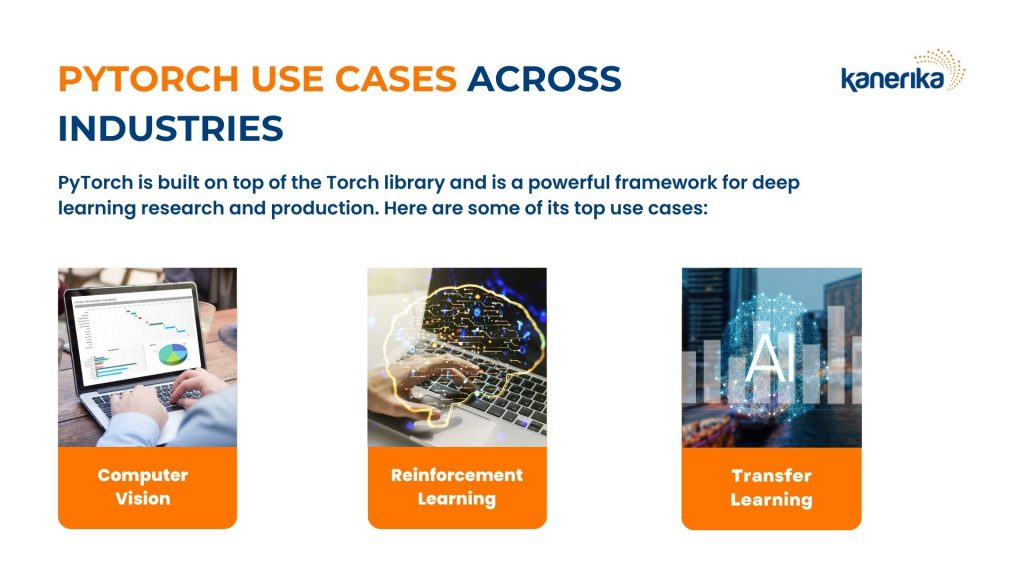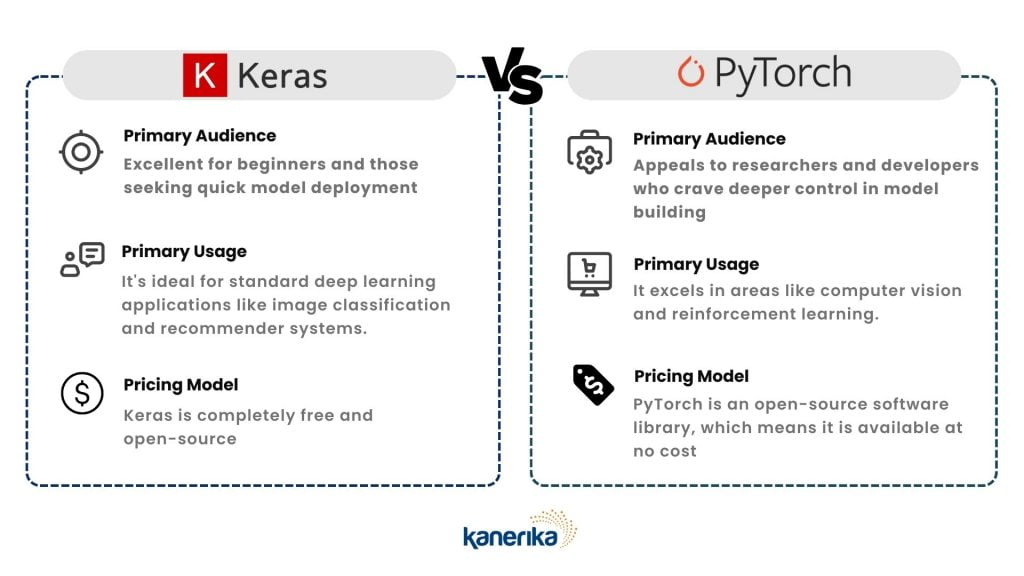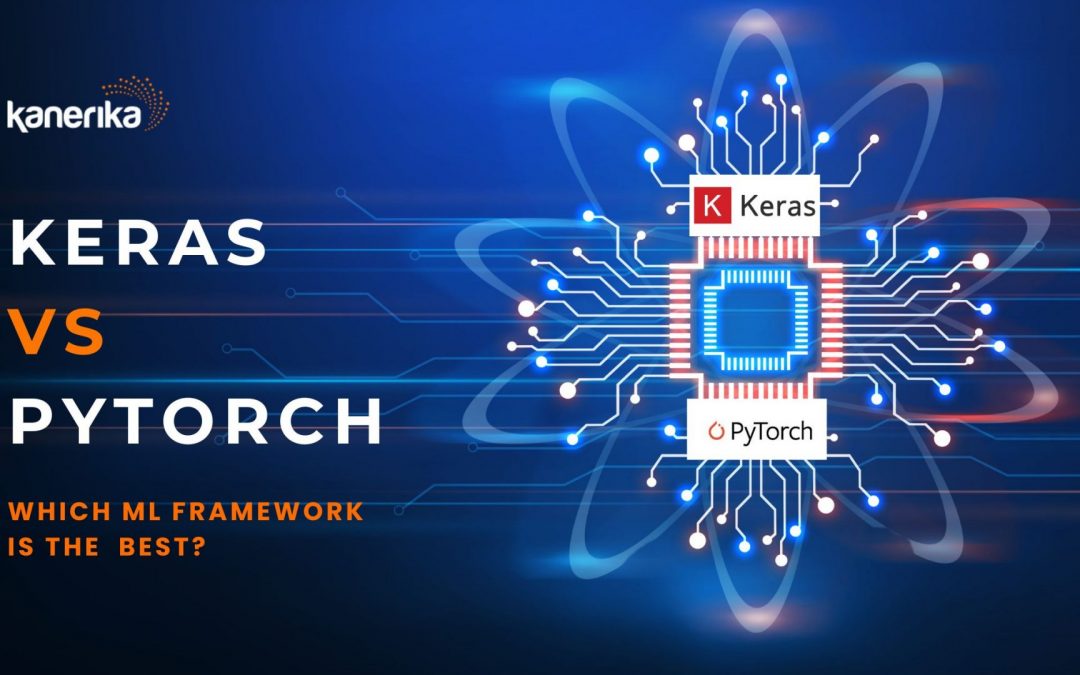Machine Learning (ML) has come a long way since its inception. Today, it’s a robust and rapidly growing technology that has reshaped nearly every aspect of modern business.
Gone are the days of static algorithms struggling to keep pace with evolving preferences. ML empowers systems to learn from vast amounts of data, identify hidden patterns, and make intelligent decisions.
It achieves all of this without any explicit programming.
Imagine personalized recommendations on your favorite streaming platform, fraud detection systems guarding your financial transactions, or predictive maintenance optimizing your business operations—these are just a glimpse of ML’s transformative potential.
But ML wouldn’t be a reality without the right tools. Enter Keras and PyTorch – powerful ML frameworks that simplify building and deploying intelligent models.
But how are these two tools different, and what are their core functionalities? In this article, we will dissect their functionality, reveal their use cases in the corporate landscape, and demonstrate what’s the best fit for your business.
Table of Contents
- Keras vs Pytorch: Understanding the Differences
- Keras vs Pytorch: Use Cases
- Keras vs Pytorch: Features
- Keras vs Pytorch: Architecture and Components
- Keras vs PyTorch: Pricing Models
- Keras vs PyTorch: Learning Curve
- Keras vs PyTorch: Comparison Summary
- Keras vs PyTorch: Which One is Right for You?
- Kanerika: Your Partner in AI/ML Implementation
- FAQs
Keras vs Pytorch: Understanding the Differences
Be it a website frontend or an artificial intelligence program, no coder starts work from scratch. Programmers commonly depend on libraries. A library refers to a collection of pre-written code or routines that can be used by a program or application.
Keras and Python are both machine learning libraries. They offer a collection of pre-built functions and tools that simplify the process of developing and deploying machine learning solutions.
What is Keras?
Keras is an open-source high-level neural network library that supports multiple backends and platforms for deep learning models.
It was developed by one of the Google engineers, Francois Chollet, and is written in Python. Keras is capable of running on Theano, TensorFlow, or CNTK.
Keras is a high level API, and modular for swift training and experimentation with deep neural networks. It supports both Convolutional Networks and Recurrent Networks individually and together.
Big companies like Microsoft, Google, NVIDIA, and Amazon have actively contributed to the development of Keras. It has amazing industry interaction, and it is used in software development by firms like Netflix, Uber, Google, Expedia, etc.
What is PyTorch?
PyTorch is an open-source machine learning library that was developed by Facebook’s AI Research Lab in January 2016. It is mainly used in computer vision, deep learning, and natural language processing applications.
PyTorch is built on top of the Torch library and is available with a Python and C++ interface. It is a powerful framework for deep learning research and production.
PyTorch has become an essential tool for solving machine learning problems. It covers every step of the machine learning workflow, from data processing to hyperparameter tuning to deployment. PyTorch provides high flexibility to all of its developers by integrating low-level deep learning languages such as TensorFlow or Theano.
Keras vs Pytorch: Use Cases
Keras and PyTorch are both open-source machine learning libraries that are useful in building and training neural networks. However, there are some differences between the two.
Keras is a high-level API built on top of TensorFlow. PyTorch, on the other hand, is a low-level computation framework with superior debugging, pliability, and performance capabilities built on top of the Torch library.
Keras Use Cases

Keras is suitable for developers who want a plug-and-play framework that lets them build, train, and evaluate their models quickly.
- Image Classification: Keras can be used for image classification tasks, such as identifying objects in images. Keras can classify images of handwritten digits in the MNIST dataset.
- Natural Language Processing: Keras can be used for natural language processing tasks, such as sentiment analysis or text classification. For example, Keras can classify movie reviews as positive or negative based on their text content.
- Recommender Systems: Keras can be used to build recommender systems that suggest products or services to users based on their past behavior. Keras is commonly used to build movie recommendation systems based on user ratings.
PyTorch Use Cases

PyTorch is ideal for researchers and developers who want more control over the low-level details of their models.
- Computer Vision: PyTorch can be used for computer vision tasks, such as object detection or image segmentation. It can detect objects in images and videos.
- Reinforcement Learning: PyTorch can be used for reinforcement learning tasks, such as training agents to play games. For example, PyTorch has been used to train an agent to play the game of Go.
- Transfer Learning: Taking a pre-trained model built on a large dataset and applying it to a new, smaller dataset for faster training. This method is highly efficient as it allows for leveraging the learned features and knowledge from the initial model.
Keras vs Pytorch: Features
Understanding the functionalities of Keras and PyTorch is crucial for businesses deciding between these ML libraries. Let’s explore the key features of each framework and their specialized capabilities.
Core Features of Keras
- Modular and Composable: Keras models are created by connecting configurable building blocks with minimal restrictions.
- Workflows with Less Cognitive Load: Keras simplifies the development process by reducing cognitive burden. It supports both simple and advanced workflows, making it accessible for users of varying expertise.
- Support for Multiple Backends: Keras can run on TensorFlow, Microsoft Cognitive Toolkit, Theano, or PlaidML.
- Comprehensive Coverage of Neural Network Building Blocks: It includes numerous implementations of layers, objectives, activation functions, optimizers, and tools.
- Facilitates Fast Experimentation: Keras is designed for quick and easy experimentation with deep neural networks. The framework lowers the barrier to entry into deep learning.
- Integration with Deep Learning Infrastructure: Keras integrates seamlessly with TensorFlow’s ecosystem. It supports advanced features like distributed training, performance optimization, and production deployment.
Core Features of PyTorch
- Dynamic Computation Graphs: PyTorch uses dynamic computation graphs. This means the graphs are built along code execution. This feature allows for more flexibility and ease in making changes to the architecture.
- Ease of Use and Pythonic Nature: PyTorch is designed to be intuitive and aligns well with Python programming conventions. This makes it easy for developers familiar with Python to adopt and use PyTorch effectively.
- Strong GPU Acceleration: PyTorch provides robust support for GPU acceleration. GPU scaling is essential for handling large-scale computations and speeds up the training process significantly.
- TorchScript for Model Serialization: TorchScript is a feature in PyTorch that allows for the serialization of models. It makes them portable for use in different environments, including ones where Python is not installed.
- Extensive Library and Community Support: PyTorch boasts a wide range of libraries and tools contributed by a large community. This ecosystem includes libraries for different domains, like computer vision and natural language processing.
- Distributed Training: PyTorch supports distributed training, making it easier to scale up computations and handle large datasets efficiently. This feature is crucial for training complex models on large-scale data.
Keras vs Pytorch: Architecture and Components
Keras and PyTorch are two of the most popular deep learning libraries, each with its own unique architecture and components. They cater to different needs and preferences in the machine learning community.
Keras Architecture and Components
Keras’ architecture allows for easy and fast prototyping of deep learning models. It provides a more straightforward, higher-level set of building blocks to work with, making it suitable for beginners due to its ease of use and simplicity.
- Modularity: It is designed with a focus on modularity, allowing for easy and quick construction and experimentation of deep neural networks.
- Backend Agnostic: Keras can run on top of TensorFlow, Microsoft Cognitive Toolkit, Theano, or PlaidML, providing flexibility in choosing the backend engine.
- Predefined Layers: Offers a wide range of predefined layers and pre-trained models, facilitating the rapid development and deployment of deep learning models.
- Sequential and Functional APIs: Supports two main types of models – the Sequential model for linear stacks of layers and the Functional API for more complex architectures.
- Easy Model Training and Evaluation: Includes built-in support for training, evaluating, and making predictions with models.
- Data Preprocessing: Provides utilities for data preprocessing, data augmentation, and working with image and text data.
PyTorch Architecture and Components
PyTorch offers a more flexible, imperative programming style, where the network’s behavior depends on the Python code. PyTorch’s architecture is more about direct work with array expressions.
- Tensors: Multi-dimensional arrays hold data, similar to NumPy arrays, but offer GPU acceleration and automatic differentiation.
- Autograd: Automatic differentiation engine that computes gradients for efficient backpropagation during training.
- Loss Functions: Metrics used to evaluate the error of a model’s predictions, guiding optimization.
- Distributed Training: Supports scalable distributed training and performance optimization, which is crucial for handling large datasets and complex models.
- Eager Execution: PyTorch operates on an eager execution model, which means that operations evaluation happens simultaneously, making debugging easier.
- Customizability and Control: Offers a lower-level approach for model development, providing more control and customization options for research.
Keras vs PyTorch: Pricing Models
Keras is completely free and open-source. This means you can download, use, modify, and redistribute it without any cost.
This applies to both individuals and organizations, making it a highly accessible tool for anyone interested in deep learning.
PyTorch is also an open-source software library, which means it is available at no cost.
Users can freely download, use, and modify it for their projects. There are no licensing fees or subscription costs associated with using PyTorch.
However, keep in mind that deploying these models is a costly proposition.
Running deep learning models requires powerful GPUs. Purchasing or renting these can be expensive. GPU offerings like Google Cloud TPUs cost hundreds of thousands of dollars in annual rent.
Keras vs PyTorch: Learning Curve
Both Keras and PyTorch are ML libraries. Anyone wanting to use them must have prior knowledge of Python and C++. A strong foundation in mathematics, particularly in linear algebra, calculus, probability, and statistics, is also crucial.
Keras – Plug-and-Play Framework
While Keras is accessible and designed for ease of use, it still requires an effort to learn effectively. Prior knowledge of Tensorflow is essential. Once you have mastered that, it takes about 2-7 days to understand how Keras works.
PyTorch – Its Flexibility Makes It a Powerful Tool
PyTorch’s code is closer to the underlying machinery of deep learning, requiring greater control and understanding of computational details. PyTorch requires more manual management of memory and computation. For someone proficient in Python, it would take about two weeks to master the PyTorch library.
Keras vs PyTorch: Comparison Summary
Let’s summarize our discussion so far and understand the key differences between PyTorch vs Keras:
| Aspect | Keras | PyTorch |
| PyTorch vs Keras Overview | A high-level neural network library, supporting multiple backends. Developed by Google engineer Francois Chollet. Designed for swift training and experimentation with deep neural networks. | An open-source machine learning library developed by Facebook’s AI Research Lab. Known for its flexibility in deep learning research and production. |
| PyTorch vs Keras Use Cases | Ideal for plug-and-play frameworks, quick model building, image classification, natural language processing, and recommender systems. | Suited for researchers needing low-level control, computer vision tasks, reinforcement learning, and transfer learning. |
| Keras vs PyTorch Features | Modular, supports multiple backends, comprehensive coverage of neural network elements, fast experimentation, and integration with TensorFlow’s ecosystem. | Dynamic computation graphs, pythonic nature, strong GPU acceleration, TorchScript for model serialization, extensive library and community support, distributed training. |
| Keras vs PyTorch Architecture and Components | Focuses on modularity and ease of use. Backend agnostic, with predefined layers, sequential and functional APIs, and easy model training and evaluation. | Emphasizes flexibility with tensors, Autograd for automatic differentiation, loss functions, distributed training, eager execution, and customizability. |
| PyTorch vs Keras Pricing Models | Free and open-source. | Also free and open-source. However, deploying models, especially those requiring GPUs, can be costly. |
| PyTorch vs Keras Learning Curve | Easier to learn, suitable for beginners. Requires a foundational understanding of TensorFlow. | Steeper learning curve due to its lower-level approach. Requires understanding of Python and a deeper grasp of computational details. |
Keras vs PyTorch: Which One is Right for You?

PyTorch and Keras are both robust machine learning frameworks, but they cater to different needs.
Keras, with its high-level API and modular design, is excellent for beginners and those seeking quick model deployment. It’s ideal for standard deep learning applications like image classification and recommender systems.
PyTorch, offering a dynamic computation graph and a more Pythonic approach, appeals to researchers and developers who crave deeper control in model building. It excels in areas like computer vision and reinforcement learning.
Keras simplifies the journey into deep learning, while PyTorch provides flexibility for innovative solutions. Your choice depends on your project’s complexity and your comfort with deep learning concepts.
Kanerika: Your Partner in AI/ML Implementation
Selecting the right implementation partner is one of the most crucial steps in an effective AI/ML implementation in an organization.
Kanerika’s extensive expertise in AI/ML frameworks such as Keras and PyTorch, combined with comprehensive data management and robust analysis capabilities, positions it uniquely in the USA as a leading AI/ML implementation partner.
Starting with a thorough pre-assessment of your needs, Kanerika’s team conducts an in-depth analysis to provide tailored recommendations for your business.
Kanerika’s strategic alignment ensures the scalability and future-proofing of solutions. While its collaborative approach guarantees that the solutions align perfectly with your business objectives.
Contact Kanerika for a free consultation today!















